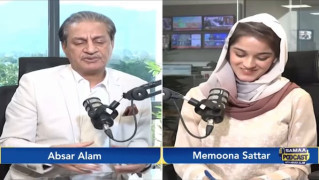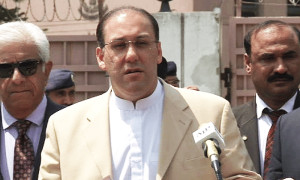Islamabad faces external financing gap of around $12b
 [FONT=&]
[FONT=&]
The government’s external debt related obligations in the current fiscal year will be $5.9 billion - higher by 38% over the finance ministry’s earlier estimates.
ISLAMABAD: In an exposé that shows the extent of pressure on the external account, State Bank of Pakistan (SBP) Governor Tariq Bajwa said on Tuesday that Pakistan faces an external financing gap of around $12 billion in the current fiscal year.
The gap is in the range of $11 billion to $12 billion, said Bajwa after attending a meeting of the National Assembly Standing Committee on Finance and Revenue. The central bank governor gave an in-camera briefing to the parliamentary body on the reasons behind the weakening rupee and the “grave challenges” to the economy in the months ahead.
The decision to hold the meeting without the presence of media was taken suddenly, as the finance ministry and the SBP did not want to share the negative news on the external front with the public
The governor also did not share with the media the source of funds for the huge $12-billion financing gap if Pakistan wants to ensure gross official foreign currency reserves do not fall below $14.6 billion. He also ruled out the possibility of floating another sovereign bond in the coming months.
Chances are that the gap will be filled by using official foreign currency reserves as well as resorting to more short- and long-term borrowings including from foreign commercial banks.
Pakistan’s gross external financing requirements are roughly $20 billion, which includes an estimated $14-billion current account deficit and another $5.9-billion foreign debt repayment component during the current fiscal year. Of the $20 billion, the government has around $9 billion, which leaves net financing gap of about $11-12 billion
After the conclusion of the recently-held Post Programme Monitoring talks, the International Monetary Fund (IMF) had said that Pakistan’s external sector would continue to remain under pressure. Former finance minister Dr Hafiz Pasha last week forewarned that the country was in an incipient financial crisis that will remain for a longer period.
The statement about the quantum of the external financing gap comes amid another disclosure that the government’s external debt related obligations in the current fiscal year will be $5.9 billion – higher by 38% over the finance ministry’s earlier estimates. In response to a question, Finance Secretary Shahid Mahmood informed the standing committee that during the current fiscal year the government’s external debt obligations are $5.9 billion.
The figure is $1.64 billion or 38% higher than the projections that the finance ministry had earlier shared with the National Assembly in writing. This shows that either the finance ministry concealed the real facts from parliament or it did not know exactly the quantum of external debt obligations.
The finance secretary said that out of $5.9 billion, the government has already paid $2.4 billion on account of principal and interest on these loans. He said that remaining $3.5 billion will be paid in the coming seven months.
While responding to a question on exchange rate, Bajwa said that since July this year, the rupee has cumulatively shed its value by over 7.22% including 5% in the recent past. The SBP governor did not comment on the future course of the rupee.
To a question whether the SBP was immediately in a position to return $6.16 billion that it has borrowed from the commercial banks for the short term, the governor said that the SBP can return these loans. But he did not answer what was the reason to take the $6-billion loans from commercial banks.
Pasha said that excluding the over $6 billion in loans that the SBP took from commercial banks, the central bank’s net reserves will fall to $3 billion by June 2018. But the SBP governor said that Pasha’s estimates were “very conservative” and the SBP will perform better than this.
As of November this year, the central bank borrowed $6.16 billion from commercial banks under the forward and currency swap arrangements, according to SBP data. This amount is also shown part of both the central bank and commercial bank’s reserves, as also admitted by Dr Miftah Ismail, Special Assistant to Prime Minister on Economic Affairs in a TV programme.
As of December 8, 2017, the SBP’s official foreign currency reserves were $14.66 billion including $6.16 billion worth of currency swaps and forward contracts. In 1998, the then PML-N government had consumed foreign currency deposits of commercial banks after global powers imposed sanctions on Pakistan in retaliation to nuclear tests.
Published in The Express Tribune, December 20[SUP]th[/SUP], 2017.
‘IMF could impose non-economic conditions on Pakistan this time’
[FONT=&]By Shahbaz Rana
[/FONT]
[FONT=&]Published: December 19, 2017[/FONT]

ISLAMABAD: Pakistan is in an incipient financial crisis which, unlike previous ones, may prolong and the International Monetary Fund (IMF) could exploit the situation by asking the country to cut back on the size of the China-Pakistan Economic Corridor (CPEC), former finance minister Hafeez Pasha cautioned on Monday.
“[And] When Pakistan knocks on the IMF’s door, the United States being the largest shareholder could impose some “non-economic” conditions,” Pasha warned while speaking at a seminar organised by the German institute Friedrich-Ebert-Stifting.
Pasha has in the past negotiated several bailout packages with the IMF and is critical of the fund’s policies towards Pakistan.
By September next year, the government will run out of foreign currency reserves which will trigger a financial crisis, Pasha said.
According to his forecast, Pakistan’s external financing needs will be $32 billion for the next 16 to 18 months, of which only $8 billion will come through CPEC financing and foreign direct investment whereas the government will have to resort to borrowing to cover the rest.
Pakistan has been facing difficulties in managing its external account due to mounting foreign debt repayments and a widening current account deficit. The country raised $2.5 billion last month by floating bonds to take pressure off the falling foreign exchange reserves.
“Financial crises of 2008 and 2013 were the result of major price shocks, but this time the crisis will be the result of structural faults in the economy,” Pasha warned.
“Instead of undertaking much-needed reforms, the government is conducting a ‘holding operation’ that is aimed at keeping foreign currency reserves at a level that will allow it to defer the crisis till June next year,” Pasha said. “During this period, the economy will be allowed to bleed and no major reforms will be undertaken.”
The former finance minister predicted that the real challenge would emerge after departure of the caretaker government. “By that time, cracks will widen and foreign currency reserves will fall below $3 billion,” he said.
Pasha was of the view that the only way out would be another bailout from the IMF. “But this time, the IMF will not allow a joyride to Pakistan due to change in the US policy stance towards Pakistan.”
“We may be told that CPEC’s size needs to be cut down with the US asking for some non-economic conditions as well,” he added. “This is a crunch time and the Pakistan Army is rightly worried as it is aware of the strong link between economic conditions and national security.” He suggested that 5% depreciation of the rupee earlier this month could be the result of an arrangement under which Pakistan would let the currency fall in return for a Letter of Support from the IMF to borrow from other international financial institutions.
He predicted that despite the holding operation, the gross foreign currency reserves would fall to $10 billion by June next year including the $6.5 billion that the central bank had borrowed from commercial banks under a swap arrangement.
Pasha said currency swap borrowings had stood at $5.8 billion by the end of August and they jumped to $6.5 billion by November-end.
“Unlike 1998, this time the central bank will have to return the currency swap loans and it should not fiddle with foreign currency accounts,” Pasha emphasised.
In addition to problems on the external account, he said, the fiscal policy would also remain expansionary and the central government’s borrowings from the State Bank for budget financing could exceed Rs1 trillion by the end of current fiscal year.
“Over the past four and a half years, the government has pursued a path of presenting unrealistic statistics. Indicators like debt-to-GDP-ratio, inflation and economic growth are manipulated. The problem is that the government has started believing in its own manufactured data,” said Pasha.
Published in The Express Tribune, December 19[SUP]th[/SUP], 2017.
[/FONT]

The government’s external debt related obligations in the current fiscal year will be $5.9 billion - higher by 38% over the finance ministry’s earlier estimates.
ISLAMABAD: In an exposé that shows the extent of pressure on the external account, State Bank of Pakistan (SBP) Governor Tariq Bajwa said on Tuesday that Pakistan faces an external financing gap of around $12 billion in the current fiscal year.
The gap is in the range of $11 billion to $12 billion, said Bajwa after attending a meeting of the National Assembly Standing Committee on Finance and Revenue. The central bank governor gave an in-camera briefing to the parliamentary body on the reasons behind the weakening rupee and the “grave challenges” to the economy in the months ahead.
The decision to hold the meeting without the presence of media was taken suddenly, as the finance ministry and the SBP did not want to share the negative news on the external front with the public
The governor also did not share with the media the source of funds for the huge $12-billion financing gap if Pakistan wants to ensure gross official foreign currency reserves do not fall below $14.6 billion. He also ruled out the possibility of floating another sovereign bond in the coming months.
Chances are that the gap will be filled by using official foreign currency reserves as well as resorting to more short- and long-term borrowings including from foreign commercial banks.
Pakistan’s gross external financing requirements are roughly $20 billion, which includes an estimated $14-billion current account deficit and another $5.9-billion foreign debt repayment component during the current fiscal year. Of the $20 billion, the government has around $9 billion, which leaves net financing gap of about $11-12 billion
After the conclusion of the recently-held Post Programme Monitoring talks, the International Monetary Fund (IMF) had said that Pakistan’s external sector would continue to remain under pressure. Former finance minister Dr Hafiz Pasha last week forewarned that the country was in an incipient financial crisis that will remain for a longer period.
The statement about the quantum of the external financing gap comes amid another disclosure that the government’s external debt related obligations in the current fiscal year will be $5.9 billion – higher by 38% over the finance ministry’s earlier estimates. In response to a question, Finance Secretary Shahid Mahmood informed the standing committee that during the current fiscal year the government’s external debt obligations are $5.9 billion.
The figure is $1.64 billion or 38% higher than the projections that the finance ministry had earlier shared with the National Assembly in writing. This shows that either the finance ministry concealed the real facts from parliament or it did not know exactly the quantum of external debt obligations.
The finance secretary said that out of $5.9 billion, the government has already paid $2.4 billion on account of principal and interest on these loans. He said that remaining $3.5 billion will be paid in the coming seven months.
While responding to a question on exchange rate, Bajwa said that since July this year, the rupee has cumulatively shed its value by over 7.22% including 5% in the recent past. The SBP governor did not comment on the future course of the rupee.
To a question whether the SBP was immediately in a position to return $6.16 billion that it has borrowed from the commercial banks for the short term, the governor said that the SBP can return these loans. But he did not answer what was the reason to take the $6-billion loans from commercial banks.
Pasha said that excluding the over $6 billion in loans that the SBP took from commercial banks, the central bank’s net reserves will fall to $3 billion by June 2018. But the SBP governor said that Pasha’s estimates were “very conservative” and the SBP will perform better than this.
As of November this year, the central bank borrowed $6.16 billion from commercial banks under the forward and currency swap arrangements, according to SBP data. This amount is also shown part of both the central bank and commercial bank’s reserves, as also admitted by Dr Miftah Ismail, Special Assistant to Prime Minister on Economic Affairs in a TV programme.
As of December 8, 2017, the SBP’s official foreign currency reserves were $14.66 billion including $6.16 billion worth of currency swaps and forward contracts. In 1998, the then PML-N government had consumed foreign currency deposits of commercial banks after global powers imposed sanctions on Pakistan in retaliation to nuclear tests.
Published in The Express Tribune, December 20[SUP]th[/SUP], 2017.
‘IMF could impose non-economic conditions on Pakistan this time’
[FONT=&]By Shahbaz Rana
[/FONT]
[FONT=&]Published: December 19, 2017[/FONT]

ISLAMABAD: Pakistan is in an incipient financial crisis which, unlike previous ones, may prolong and the International Monetary Fund (IMF) could exploit the situation by asking the country to cut back on the size of the China-Pakistan Economic Corridor (CPEC), former finance minister Hafeez Pasha cautioned on Monday.
“[And] When Pakistan knocks on the IMF’s door, the United States being the largest shareholder could impose some “non-economic” conditions,” Pasha warned while speaking at a seminar organised by the German institute Friedrich-Ebert-Stifting.
Pasha has in the past negotiated several bailout packages with the IMF and is critical of the fund’s policies towards Pakistan.
By September next year, the government will run out of foreign currency reserves which will trigger a financial crisis, Pasha said.
According to his forecast, Pakistan’s external financing needs will be $32 billion for the next 16 to 18 months, of which only $8 billion will come through CPEC financing and foreign direct investment whereas the government will have to resort to borrowing to cover the rest.
Pakistan has been facing difficulties in managing its external account due to mounting foreign debt repayments and a widening current account deficit. The country raised $2.5 billion last month by floating bonds to take pressure off the falling foreign exchange reserves.
“Financial crises of 2008 and 2013 were the result of major price shocks, but this time the crisis will be the result of structural faults in the economy,” Pasha warned.
“Instead of undertaking much-needed reforms, the government is conducting a ‘holding operation’ that is aimed at keeping foreign currency reserves at a level that will allow it to defer the crisis till June next year,” Pasha said. “During this period, the economy will be allowed to bleed and no major reforms will be undertaken.”
The former finance minister predicted that the real challenge would emerge after departure of the caretaker government. “By that time, cracks will widen and foreign currency reserves will fall below $3 billion,” he said.
Pasha was of the view that the only way out would be another bailout from the IMF. “But this time, the IMF will not allow a joyride to Pakistan due to change in the US policy stance towards Pakistan.”
“We may be told that CPEC’s size needs to be cut down with the US asking for some non-economic conditions as well,” he added. “This is a crunch time and the Pakistan Army is rightly worried as it is aware of the strong link between economic conditions and national security.” He suggested that 5% depreciation of the rupee earlier this month could be the result of an arrangement under which Pakistan would let the currency fall in return for a Letter of Support from the IMF to borrow from other international financial institutions.
He predicted that despite the holding operation, the gross foreign currency reserves would fall to $10 billion by June next year including the $6.5 billion that the central bank had borrowed from commercial banks under a swap arrangement.
Pasha said currency swap borrowings had stood at $5.8 billion by the end of August and they jumped to $6.5 billion by November-end.
“Unlike 1998, this time the central bank will have to return the currency swap loans and it should not fiddle with foreign currency accounts,” Pasha emphasised.
In addition to problems on the external account, he said, the fiscal policy would also remain expansionary and the central government’s borrowings from the State Bank for budget financing could exceed Rs1 trillion by the end of current fiscal year.
“Over the past four and a half years, the government has pursued a path of presenting unrealistic statistics. Indicators like debt-to-GDP-ratio, inflation and economic growth are manipulated. The problem is that the government has started believing in its own manufactured data,” said Pasha.
Published in The Express Tribune, December 19[SUP]th[/SUP], 2017.
[/FONT]
Last edited:

































